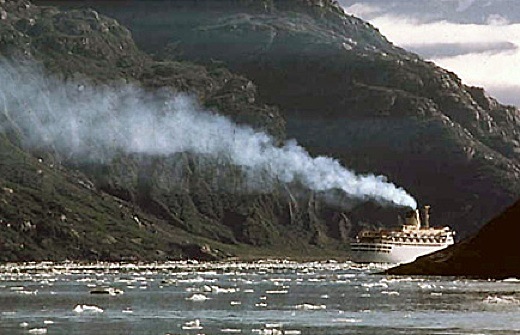 image above: Alaskan cruise ship entering inlet spewing bunker fuel pollution.
From http://thecruisepeople.ca/cruiseblog/?p=571
By Erika Bolstad on 14 October 2009 in McClatchy -
http://news.yahoo.com/s/mcclatchy/20091014/sc_mcclatchy/3333404
Some Alaska ports of call have asked the Environmental Protection Agency to rethink -- or at least slow down -- its plans to impose stricter air quality requirements for cruise ships and other large oceangoing vessels.
image above: Alaskan cruise ship entering inlet spewing bunker fuel pollution.
From http://thecruisepeople.ca/cruiseblog/?p=571
By Erika Bolstad on 14 October 2009 in McClatchy -
http://news.yahoo.com/s/mcclatchy/20091014/sc_mcclatchy/3333404
Some Alaska ports of call have asked the Environmental Protection Agency to rethink -- or at least slow down -- its plans to impose stricter air quality requirements for cruise ships and other large oceangoing vessels. The EPA wants all large vessels to stop using so-called bunker fuel within 200 nautical miles of U.S. shorelines, saying that reducing air pollution from the dirty fuel could save the lives of 8,300 people each year, help an additional 3 million people avoid respiratory problems and clear hazy skies as far inland as the Grand Canyon .
Some cities, such as Juneau , where there's long been a concern about air pollution from cruise ships, asked for the EPA to slow down its process. Others, such as Ketchikan , complain that no modeling has been done to determine there's an ambient air problem in Alaska's coastal communities.
Clean air advocates say they're dumbfounded why Alaskans who promote the natural beauty of the areas cruise ships visit would object to stricter fuel standards that keep the environment pristine.
"It's one of the great things about the cruise ships in Alaska , they're sold as 'come see this pristine environment,'" said Frank O'Donnell , of Clean Air Watch . "Well, what's wrong with making it pristine?"
Ketchikan Mayor Lew Williams III worries that regulations would make cruise operators reluctant to choose Alaska . Already, some lines are repositioning ships because of the economic downturn; an estimated 140,000 fewer passengers are set to disembark in Alaska next year.
"We're just trying to make a living and keep the economy going," Williams said. "The cruise industry's been vital for southeast Alaska ."
That concern was shared by both of Alaska's senators, Democrat Mark Begich and Republican Lisa Murkowski . Both submitted comments to the EPA , with Murkowski asking the agency to consider gathering some Alaska -specific data before imposing air quality standards based on modeling done at other U.S. port cities.
Nearly 14 percent of all employment in Alaska is tied to tourism, Begich said, adding that he is "concerned the imposition of a rule developed without consideration of environmental and economic impacts in Alaska might have the unintended consequences of exacerbating this decline."
Gov. Sean Parnell went a step further, noting the importance of cruise ships to the economies of Alaska coastal communities, but also calling into the question the science used to include most of Alaska in the EPA's proposed emissions control area. There's little air quality data backing up the EPA's rule, Parnell noted, and the agency's proposal "reflects a misunderstanding of Alaska's geography and ecosystems."
International marine protection groups such as Oceana, however, would like to see more of Alaska included in the emissions control area, not excluded, said Jackie Savitz , one of the organization's senior campaign directors. They're concerned that rapidly melting sea ice will open up parts of the Arctic to more ships, increasing pollution. Already, Savitz said, black carbon -- soot -- has been proved to reduce the reflective qualities of snow and ice and lead to additional melting.
"A lot of the impacts that we're seeing with air pollution issues, whether it be carbon dioxide or particulate matter from ships, it's having a great effect on Alaska ," Savitz said. " Alaska is in the crosshairs. You would think Alaska would be one of the first states calling for tougher regulations."
The EPA's rule should be final by December. At that time, the EPA plans to issue a rule banning the sale of high-sulfur fuel in U.S. coastal and internal waters beginning in 2012. It also would require that new engines in U.S. ships meet nitrogen oxide controls that match a North American emission control area supported by the U.S. and Canada .
By 2016, the EPA would require that new engines on vessels operating in the emission control area use equipment that reduces nitrogen oxide emissions by 80 percent.
see also:
Island Breath: Niumalu Bunker Fuel Emissions 4/14/08 Island Breath: Kauai Bunker Fuel Pollution 5/25/08
No comments :
Post a Comment